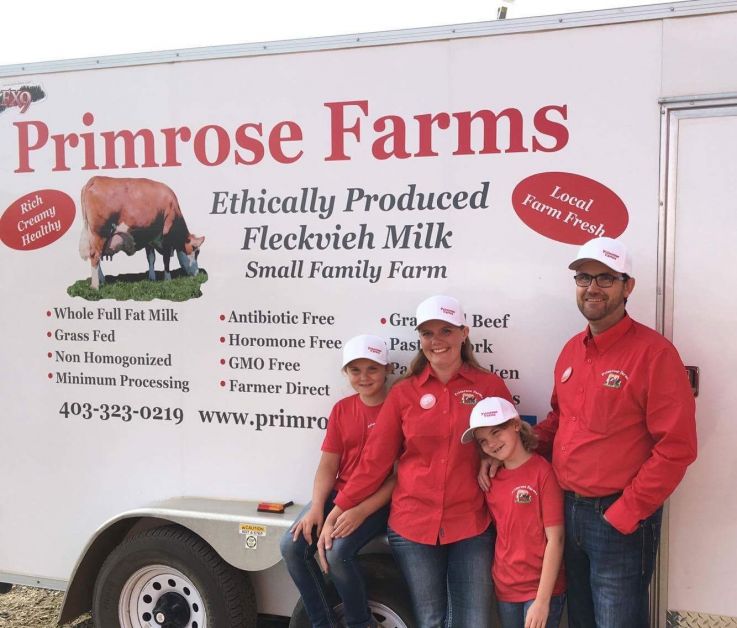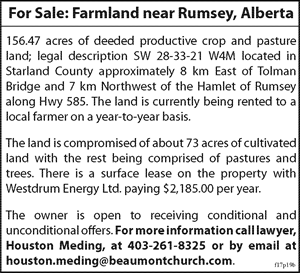
The vast majority of food products bought by consumers go from the farm gate to the store shelves, but a growing consumer interest in Alberta has been to buy directly from the farm. One local food producer has found success by focusing their business of farm direct marketing towards urban consumers.
Cornell and Cremona Primrose of Primrose Farms started direct marketing their Rowley farm four years ago and haven’t looked back. Growing up, Cremona remembers the time she ate eggs from a grocery store after being raised on eggs from her family farm.
“I thought, ‘I need to get some chickens,’” she says, which she did. The hens started producing more than her family could eat and she decided to try selling them online on Kijiji and social media. “Within 10 minutes of being on Facebook – boom, they were gone.”
They began selling other farm products to urban consumers, driving into the city to meet up in grocery store parking lots, selling beef, milk, lamb, chickens, and eggs to urban-dwellers hungry for fresh off-the-farm products.
Over the past four years Primrose Farms has built up their business largely based on the relationships they’ve developed with consumers, who choose to forgo the ease of simply shopping in a grocery store because they have come to want fresh food products and have developed a direct relationship with farmers like the Primrose’s.
“Nintey-nine per cent of consumers aren’t interested in paying a higher price for a premium product from the farm, but there is a customer base. We’re not certified organic, they’re not purchasing a label – what is happening is that they are more comfortable buying the products because it creates a trust relationship with the consumer. Essentially what you’ve done is you’ve sold the farm, your business to them,” says Cornell.
He says most consumers are completely disconnected from the complicated, highly-efficient, industrialized consumer food industry which most of us get our food through – where food from the farm goes through supply management where products such as milk are mixed together, repackaged, and resold to consumers who have no idea where the food they are eating comes from.
“There are many in the agricultural industry skeptical of opening their doors. They’re pessimistic that any person is on an agenda as extreme as PETA or Greenpeace but the reality is that it’s not the case…. The consumers are removed from agriculture but on the same token, the majority of the farmers are completely removed from their customers,” Cornell says.
Their farm, and others like it, who have an open-door policy which allows consumers to come see exactly where their food is coming from are a growing interest to consumers who are tired of some food industry practices. One of those is the vast majority of dairy in North America is produced by Holstein cows, the black and white spotted cows typically portrayed to consumers as grazing in open, green fields. Primrose Farms raised Fleckvieh products, cows which are both dairy and beef cows and known for their muscularity and robustness, compared to Holstein cows which by their nature are thinner, frailer animals but which are favoured by the dairy industry for their higher volume of milk production.
Being dual purposed for both meat and dairy, Fleckvieh cows also meet two consumer needs rather than one which diversifies their production, something which Cornell believes small ag producers need to focus on in today’s market. The recent signing of a new trade agreement with the US was a hit to the Canadian dairy industry which already has producers facing low margins and high room for failure.
“You have to structure your business so it survives, so you weather the system. There’s a lot about farming which feels out of control – government policy, weather. I’ve said this for the last few years to my family, friends, and others in the industry, that my personal belief is, whether you’re a small farm or a large corporate farm or anything in between, it’s my strong belief the long term future for agriculture is ‘value-added’ of sorts,” he says. “The idea of just producing a pound of beef or a bushel of grain is not sustainable.”
When they set out to build their farm 18 years ago, they wanted to create a place where animal comfort was important. They say ‘they don’t define the success of our farm based on product output,” but on balancing profits with quality of life. The farm has a robotic milking system where cows voluntarily get milked multiple times a day, and who live in a barn where they get to socialize together rather than being confined to individual stalls. They say they regularly hear from visitors their animals look healthier and happier than in other places.
Cremona remembers back on her family farm growing up and the diversity of livestock there. Chickens, lamb, cattle, and pigs living together with the farmers instead of being separated into industrialized warehouses of individual stalls and mechanized feeding lots.
“Cremona always says we’re trying to go back to how our grandparents farmed, when food was real.”
“But you can’t really do that now, it’s garbage. In some ways we are going ass-backwards,” she says.
Primrose Farms has taken a break from direct marketing dairy since September but currently offers select other products on their website.



























